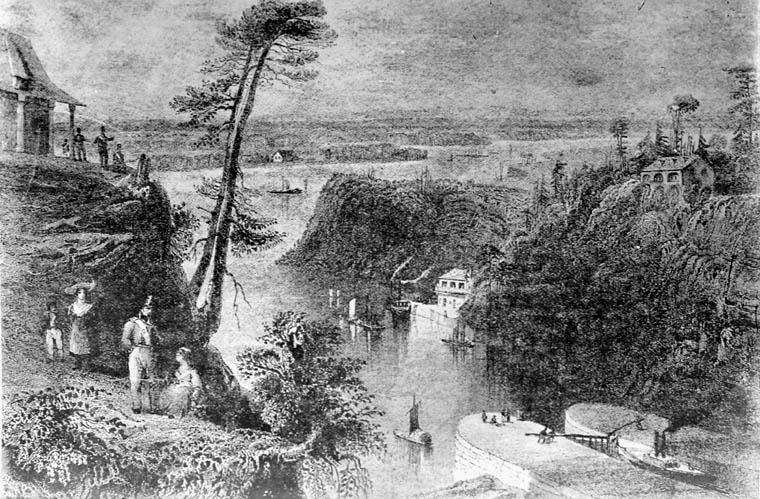|
Inner Harbour, Kingston
Inner Harbour is a neighbourhood located in downtown Kingston, Ontario, Canada. The Inner Harbour district is bounded by Joseph Street to the north, Princess Street to the south, Division Street on the west and the Cataraqui River on the east. The area is within the King's Town District. The District is represented on Kingston City Council by Councillor Rob Hutchison for the 2010-14 term of office. The average family income for the area is $45,715 which is lower than the city average. The Inner Harbour area consists primarily of working-class families with commercial activity focused primarily along Princess and Queen Streets on the south side of the neighbourhood. In the past the demographics of the Inner Harbour in addition to other north Kingston neighbourhoods contributed to local negativity toward living "north of Princess". The term refers to areas located on the north side of Princess Street, which is the main east–west thoroughfare through Kingston, and runs the length ... [...More Info...] [...Related Items...] OR: [Wikipedia] [Google] [Baidu] |
Neighbourhood
A neighbourhood (Commonwealth English) or neighborhood (American English) is a geographically localized community within a larger town, city, suburb or rural area, sometimes consisting of a single street and the buildings lining it. Neighbourhoods are often social communities with considerable face-to-face interaction among members. Researchers have not agreed on an exact definition, but the following may serve as a starting point: "Neighbourhood is generally defined spatially as a specific geographic area and functionally as a set of social networks. Neighbourhoods, then, are the Neighbourhood unit, spatial units in which face-to-face social interactions occur—the personal settings and situations where residents seek to realise common values, socialise youth, and maintain effective social control." Preindustrial cities In the words of the urban scholar Lewis Mumford, "Neighborhoods, in some annoying, inchoate fashion exist wherever human beings congregate, in permanent famil ... [...More Info...] [...Related Items...] OR: [Wikipedia] [Google] [Baidu] |
Kingston, Ontario
Kingston is a city in Ontario, Canada, on the northeastern end of Lake Ontario. It is at the beginning of the St. Lawrence River and at the mouth of the Cataraqui River, the south end of the Rideau Canal. Kingston is near the Thousand Islands, a tourist region to the east, and the Prince Edward County, Ontario, Prince Edward County tourist region to the west. Kingston is nicknamed the "Limestone City" because it has many heritage buildings constructed using local limestone. Growing European exploration in the 17th century and the desire for the Europeans to establish a presence close to local Native occupants to control trade led to the founding of a New France, French trading post and military fort at a site known as "Cataraqui" (generally pronounced ) in 1673. The outpost, called Fort Cataraqui, and later Fort Frontenac, became a focus for settlement. After the Conquest of New France (1759–1763), the site of Kingston was relinquished to the British. Cataraqui was renamed K ... [...More Info...] [...Related Items...] OR: [Wikipedia] [Google] [Baidu] |
Cataraqui River
The Cataraqui River ( ) forms the lower portion of the Rideau Canal and drains into Lake Ontario at Kingston, Ontario. The name is taken from the original name for Kingston, Ontario; its exact meaning, however, is undetermined. Early maps showed several name variations including the Great Cataraqui River and Grand River Cataraquay. The river was once called Riviere de Frontenac, or Frontenac River. The alternate spelling "Cadaraqui" also appears in some historic texts. A portion of the Cataraqui River that significantly widens north from Charon Point is also known as River Styx. The Cataraqui Region Conservation Authority administers water management concerns within the Cataraqui River watershed. History Prior to the Rideau Canal being built (1826 – 1832), the Cataraqui River had its headwaters in Dog and Loughborough Lakes.Watson, Ken W. (2007), The Rideau Route: Exploring the Pre-Canal Waterway, Ken W. Watson., It was a meandering creek, a 1795 map (by surveyor Lewis G ... [...More Info...] [...Related Items...] OR: [Wikipedia] [Google] [Baidu] |
Gentrification
Gentrification is the process whereby the character of a neighborhood changes through the influx of more Wealth, affluent residents (the "gentry") and investment. There is no agreed-upon definition of gentrification. In public discourse, it has been used to describe a wide array of phenomena, sometimes in a pejorative connotation. Gentrification is a common and controversial topic in urban politics and urban planning, planning. Gentrification often increases the Value (economics), economic value of a neighborhood, but can be controversial due to changing Demography, demographic composition and potential displacement of incumbent residents. Gentrification is more likely when there is an undersupply of housing and rising home values in a metropolitan area. The gentrification process is typically the result of increasing attraction to an area by people with higher incomes spilling over from neighboring cities, towns, or neighborhoods. Further steps are increased Socially responsib ... [...More Info...] [...Related Items...] OR: [Wikipedia] [Google] [Baidu] |
La Salle Causeway
The La Salle Causeway is a causeway that allows Highway 2 to cross the Cataraqui River (the southern entrance of the Rideau Canal) at Kingston, Ontario. The causeway separates Kingston's inner and outer harbours. Construction of the causeway was completed on April 15, 1917. The causeway transports approximately 23,000 vehicles daily. Three bridges are incorporated into the causeway, the center one being a Strauss trunnion bascule lift bridge, which was designed by Joseph Strauss, who designed the Golden Gate Bridge in San Francisco. The La Salle Causeway was named after René-Robert Cavelier, Sieur de La Salle. who oversaw the construction of Fort Frontenac in 1673 at what is now the western end of the causeway. History The first attempt at transportation across the river was a cable-operated scow type of ferry that began operating in 1786. Two rowboats were often available for use as well. In 1826, the Cataraqui Bridge Company was formed to build a wooden bridge "180 ... [...More Info...] [...Related Items...] OR: [Wikipedia] [Google] [Baidu] |
Kingston, Ontario Inner Harbour
The Kingston, Ontario Inner Harbour is situated at the south end of the Cataraqui River northeast of the downtown core of Kingston, Ontario, Canada Canada is a country in North America. Its Provinces and territories of Canada, ten provinces and three territories extend from the Atlantic Ocean to the Pacific Ocean and northward into the Arctic Ocean, making it the world's List of coun .... It is the section of Kingston Harbour that is north of the La Salle Causeway. Geography of Kingston, Ontario Transport in Kingston, Ontario {{EasternOntario-geo-stub ... [...More Info...] [...Related Items...] OR: [Wikipedia] [Google] [Baidu] |
Rideau Canal
The Rideau Canal is a 202-kilometre long canal that links the Ottawa River at Ottawa with the Cataraqui River and Lake Ontario at Kingston, Ontario, Canada. Its 46 Lock (water navigation), locks raise boats from the Ottawa River 83 metres (272 feet) upstream along the Rideau River to the Rideau Lakes, and from there drop 50 metres (164 feet) downstream along the Cataraqui River to Kingston. The Rideau Canal opened in 1832 for commercial shipping. Freight was eventually moved to railways and the St. Lawrence Seaway, but the canal remains in use today for pleasure boating, operated by Parks Canada from May through October. It is the oldest continuously operated canal system in North America, and is a UNESCO World Heritage Site. Toponymy It is named for the Rideau River, which was in turn named for Rideau Falls. The name ''Rideau'', French for "curtain", is derived from the curtain-like appearance of the falls where they join the Ottawa River. History Plan After the War of ... [...More Info...] [...Related Items...] OR: [Wikipedia] [Google] [Baidu] |
Slush Puppie Place
Slush Puppie Place (formerly Leon's Centre) is a 5,000-seat indoor arena in downtown Kingston, Ontario. Opened in 2008 as the K-Rock Centre, it is the home of the Kingston Frontenacs of the Ontario Hockey League (OHL). History The arena was designed by Brisbin Brook Beynon Architects, and was constructed by EllisDon Construction. It was built on city-owned land known as the "North Block", which at the time was being used as a parking lot. An archaeological dig of the area was necessary since the southeast portion of the site was the former location of part of the historic Fort Frontenac. The remaining ruins of the fort's northwest bastion is located directly across the street from the main entrance. The groundbreaking ceremony took place July 28, 2006, with construction beginning on November 3, 2006. On February 6, 2008, local radio station CIKR-FM purchased the naming rights to the arena for 10 years in a $3.3 million agreement, naming it the K-Rock Centre. In February 201 ... [...More Info...] [...Related Items...] OR: [Wikipedia] [Google] [Baidu] |
The Princess Of Wales' Own Regiment
''The'' is a grammatical article in English, denoting nouns that are already or about to be mentioned, under discussion, implied or otherwise presumed familiar to listeners, readers, or speakers. It is the definite article in English. ''The'' is the most frequently used word in the English language; studies and analyses of texts have found it to account for seven percent of all printed English-language words. It is derived from gendered articles in Old English which combined in Middle English and now has a single form used with nouns of any gender. The word can be used with both singular and plural nouns, and with a noun that starts with any letter. This is different from many other languages, which have different forms of the definite article for different genders or numbers. Pronunciation In most dialects, "the" is pronounced as (with the voiced dental fricative followed by a schwa) when followed by a consonant sound, and as (homophone of the archaic pronoun ''thee' ... [...More Info...] [...Related Items...] OR: [Wikipedia] [Google] [Baidu] |
Providence Continuing Care Centre
Providence Care is a teaching hospital affiliated with Queen's University located in Kingston, Ontario that was built in 1861. Providence Care is a not-for-profit organization governed by a volunteer Board of Directors and sponsored by the Catholic Health Corporation of Ontario. The Worship Centre overlooks Lake Ontario and was designed with input from faith leaders from the Kingston, Ontario community. Providence Care has 585 patient beds. Providence Care is a partner within Kingston's University hospitals in the Southeast LHIN, delivering health care, conducting research and training health care professionals. History Providence Care was founded on December 13, 1861 by the Sisters of Providence of St. Vincent de Paul to meet the physical, emotional, social and spiritual needs of its patients with respect, dignity and compassion. The centre has three sites. The budget and range of programs and services are a result of government-directed OHIP hospital restructuring that consoli ... [...More Info...] [...Related Items...] OR: [Wikipedia] [Google] [Baidu] |
Belle Island (Kingston, Ontario)
Belle Island is a forested island located in the Cataraqui River, north of downtown Kingston, Ontario. The island is noted for evidence of prehistoric Native use such as hunting and fishing, and for the existence of a burial ground. The island is about 44 hectares in size. History The island was named Isle aux Recolets during the years of occupation by the French, and Isle au Père after the British occupied the area. The current name, Belle Island, appears after 1828. Evidence of use by Native groups for hunting and fishing in the Middle Woodland Period have been discovered on the island. A burial ground was uncovered by accident in 1988 when the City was constructing a beach. The remains of three males, one female, and three children were uncovered by archaeological work in 1990 and reburied in a nearby location in 2000. One of the males was determined to have died because of a bone projectile point which had entered the chest area. Fragments of early tools, pottery and oth ... [...More Info...] [...Related Items...] OR: [Wikipedia] [Google] [Baidu] |






